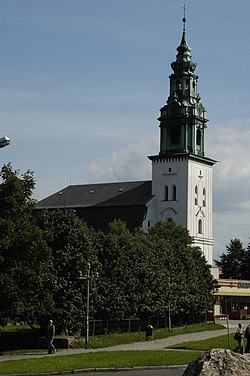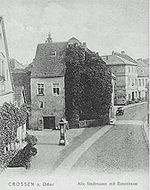| Revision as of 09:19, 18 May 2023 editKiwipete (talk | contribs)Autopatrolled, Extended confirmed users, IP block exemptions, Pending changes reviewers163,949 editsm Format administrative division links, remove DEFAULTSORTKEY as per WP:SORTKEY, minor formatting changes (AWB)Tag: AWB← Previous edit | Revision as of 03:12, 7 June 2023 edit undoAlphathon (talk | contribs)Extended confirmed users, Pending changes reviewers21,964 editsm →HistoryNext edit → | ||
| Line 50: | Line 50: | ||
| The town changed hands several times; once it was given as payment to soldiers of the ] margraves of ]. When the last Piast duke ] died without issue in 1476, his widow ], daughter of Elector ], inherited the territory of Crossen. The Brandenburg influence met with fierce opposition by Henry's cousin Duke ] of ], who devastated Krosno but in 1482 had to sign an agreement with Albert Achilles, who was able to retain the Krosno area. As a former part of the Duchy of Głogów it officially remained a ] of the ] until in 1538 King ], renounced all rights to ''Crossen'' in 1538, thereby finalizing the district's belonging to the ] region of the Brandenburg margraviate. | The town changed hands several times; once it was given as payment to soldiers of the ] margraves of ]. When the last Piast duke ] died without issue in 1476, his widow ], daughter of Elector ], inherited the territory of Crossen. The Brandenburg influence met with fierce opposition by Henry's cousin Duke ] of ], who devastated Krosno but in 1482 had to sign an agreement with Albert Achilles, who was able to retain the Krosno area. As a former part of the Duchy of Głogów it officially remained a ] of the ] until in 1538 King ], renounced all rights to ''Crossen'' in 1538, thereby finalizing the district's belonging to the ] region of the Brandenburg margraviate. | ||
| With Brandenburg, Crossen became part of the ] in 1701. In reforms after the ], the town became part of the ] in 1815 and was the seat of Landkreis Crossen as part of ] |
With Brandenburg, Crossen became part of the ] in 1701. In reforms after the ], the town became part of the ] in 1815 and was the seat of Landkreis Crossen as part of ]. As a result of the ], it became part of the ] in 1871. In May 1886 the town was devastated by a whirlwind.<ref name=EB1911/> | ||
| In 1945 during ], the town was conquered by the Soviet ]. After Germany's defeat in the war, the town once again became part of Poland, being east of the ]. | In 1945 during ], the town was conquered by the Soviet ]. After Germany's defeat in the war, the town once again became part of Poland, being east of the ]. | ||
Revision as of 03:12, 7 June 2023
Not to be confused with Krosno in the Subcarpathian Voivodeship.Place in Lubusz Voivodeship, Poland
| Krosno Odrzańskie | |
|---|---|
 Parish church Parish church | |
 Flag Flag Coat of arms Coat of arms | |
 | |
| Coordinates: 52°2′N 15°6′E / 52.033°N 15.100°E / 52.033; 15.100 | |
| Country | |
| Voivodeship | |
| County | Krosno Odrzańskie |
| Gmina | Krosno Odrzańskie |
| Town rights | before 1238 |
| Government | |
| • Mayor | Marek Cebula |
| Area | |
| • Total | 8.11 km (3.13 sq mi) |
| Highest elevation | 85 m (279 ft) |
| Lowest elevation | 38 m (125 ft) |
| Population | |
| • Total | 11,319 |
| • Density | 1,400/km (3,600/sq mi) |
| Time zone | UTC+1 (CET) |
| • Summer (DST) | UTC+2 (CEST) |
| Postal code | 66-600 to 66-603 |
| Area code | +48 68 |
| Car plates | FKR |
| Website | http://www.krosnoodrzanskie.pl |
Krosno Odrzańskie (Template:Lang-de) is a city on the east bank of Oder River, at the confluence with the Bóbr. The town in Western Poland with 11,319 inhabitants (2019) is the capital of Krosno County. It is assigned to the Lubusz Voivodeship (since 1999), previously part of Zielona Góra Voivodeship (1975–1998).
History
The town was first mentioned as Crosno in 1005, when Duke Bolesław I Chrobry of Poland had a fortress built here in the course of his armed conflict with Emperor Henry II and the West Slavic Veleti confederation. Due to its strategic location as a point of passage across the Oder, it played an important role at the western border of the Polish kingdom with the Holy Roman Empire during the 11th to 13th centuries. In 1163 Krosno was part of the Duchy of Silesia ruled by Bolesław I the Tall of the Silesian Piasts at Wrocław. In 1201 it received its town charter by Bolesław's son Duke Henry I the Bearded. Henry erected a stone castle at Krosno, where he died in 1238 and where his widow, Hedwig of Andechs, took refuge during the 1241 Mongol invasion of Europe. When the Duchy of Wrocław was finally divided in 1251, the town became part of the newly created Duchy of Głogów under Konrad I.

The town changed hands several times; once it was given as payment to soldiers of the Ascanian margraves of Brandenburg. When the last Piast duke Henry XI of Głogów died without issue in 1476, his widow Barbara of Brandenburg, daughter of Elector Albert Achilles of Brandenburg, inherited the territory of Crossen. The Brandenburg influence met with fierce opposition by Henry's cousin Duke Jan II the Mad of Żagań, who devastated Krosno but in 1482 had to sign an agreement with Albert Achilles, who was able to retain the Krosno area. As a former part of the Duchy of Głogów it officially remained a lien of the Bohemian kingdom until in 1538 King Ferdinand I of Habsburg, renounced all rights to Crossen in 1538, thereby finalizing the district's belonging to the Neumark region of the Brandenburg margraviate.
With Brandenburg, Crossen became part of the Kingdom of Prussia in 1701. In reforms after the Napoleonic Wars, the town became part of the Province of Brandenburg in 1815 and was the seat of Landkreis Crossen as part of Regierungsbezirk Frankfurt. As a result of the Unification of Germany, it became part of the German Empire in 1871. In May 1886 the town was devastated by a whirlwind.
In 1945 during World War II, the town was conquered by the Soviet Red Army. After Germany's defeat in the war, the town once again became part of Poland, being east of the Oder–Neisse line.
Notable people
- Georg Wenzeslaus von Knobelsdorff (1699–1753) German painter and architect
- Johann Friedrich Schönemann (1704–1782), German theater director
- Alexander von Knobelsdorff (1723–1799), Prussian field marshal
- Christiane Becker-Neumann (1778–1797), German actress
- Eduard Seler (1849–1922), German anthropologist, archaeologist, philogian, and Mesoamerica scholar
- Rudolf Pannwitz (1881–1969), German author
- Hans Egidi (1890–1976), president of the Federal Administrative Court of Germany
- Alfred Henschke ps. Klabund (1890–1928), German author
- Siegfried Müller aka Kongo-Müller (1920–1983), German mercenary
- Aneta Konieczna (born 1978), canoe racer, Olympic medallist
- Tomasz Kuszczak (born 1982), footballer
Twin towns – sister cities
See twin towns of Gmina Krosno Odrzańskie.
References
- "Population. Size and structure and vital statistics in Poland by territorial division in 2019. As of 30th June". stat.gov.pl. Statistics Poland. 15 October 2019. Retrieved 25 March 2020.
- ^ Chisholm, Hugh, ed. (1911). "Crossen" . Encyclopædia Britannica. Vol. 7 (11th ed.). Cambridge University Press. pp. 509–510.
External links
- Official town website
- Jewish Community in Krosno Odrzańskie on Virtual Shtetl
| Krosno Odrzańskie County | ||
|---|---|---|
| Seat: Krosno Odrzańskie | ||
| Urban gmina |  | |
| Urban-rural gmina | ||
| Rural gminas | ||
| Gmina Krosno Odrzańskie | ||
|---|---|---|
| Town and seat |  | |
| Villages | ||